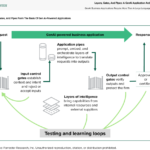Mortgage interest rates fell sharply in the first week of November following the Federal Reserve’s November meeting and its decision not to raise key rates any further. After breaking the 8% threshold in October, mortgage rates have been falling for two weeks in a row.
As of November 8, 30-year fixed mortgage rates went down by 0.25% from the previous week, according to the Mortgage Bankers Association (MBA) weekly survey. MBA data showed average 30-year mortgage rates at 7.61%, as opposed to 7.86% on November 1 and 7.9% on October 25.
Daily data from Mortgage News Daily shows that 30-year rates have risen to 7.63% as of November 13. Rates were as low as 7.32% as of November 3.
Mortgage rates have been climbing steadily since late August, but the latest downward trend could be an indicator that rates will continue going down. However, because the mortgage rate decrease is coinciding with rising unemployment, it could also be an early sign of a looming recession.
Will Rates Continue Going Down?
Economists are now confidently predicting that the Fed will not hike rates anymore this year. In fact, several have weighed in with predictions of a rate easing at some point in spring 2024. The confidence comes from the fact that the current downward trend in mortgage rates is the direct result of rising unemployment levels.
It appears that the Fed’s strategy—a combination of tightening measures and letting the labor market rebalance itself—is beginning to come to fruition. Last Friday, yields on 10-year Treasury notes fell 20 points after the U.S. Bureau of Labor Statistics released its Employment Situation Summary. Unemployment is edging closer to 4%, and while at 3.9%, unemployment levels in October weren’t much different from the 3.8% in September, the comparison with April 2023 is more stark—showing a 0.5% increase in unemployment rates.
A sustained softening of the labor market is exactly what the Fed has been looking for, and it’s the most reliable indicator that there are unlikely to be any further rate hikes this year, with a possibility of rate cuts next year. Ian Shepherdson, chief economist at Pantheon Macroeconomics, said in a note to clients: ‘’We expect no hike; the next move is likely to be an easing next spring.’’
Shepherdson reiterated this expectation in an interview with CNBC, where he said: ‘’I think that the Fed will cut rates by about 1.5% next year.’’
Shepherdson is not alone in his forecasting: Futures Markets predicts that rates will fall by 25 to 50 basis points by May 1, with a 64% probability. Goldman Sachs economists are a little more cautious but still predicting an interest rate cut by the final quarter of 2024.
Of course, certain conditions will have to be met for these predictions to come true. Shepherdson made clear that this would happen only if the market saw a ‘‘sustained diminishing’’ of pressures from wage growth and strong economic activity. He indicated that there are all the signs of a ‘’fading’’ of these pressures, which in turn would see a more relaxed approach from the Fed.
The trouble is, all of this slowing of wage growth and labor market activity sounds a lot like a recession. So, will we have one?
Will There Be a Recession in 2024?
In truth, no one really knows if there will be a recession. The current unemployment trend could trigger the Sahm rule if it continues. The Sahm rule dictates that an economy enters a recession when a three-month unemployment average is at least 0.5% higher than the lowest levels seen in the previous 12 months. We are pretty close to reaching this threshold.
However, as Shepherdson noted in the CNBC interview:
‘‘This is a very weird economy. You’ve got the Fed raising rates against a private sector whose finances generally look in pretty great shape. So, you’ve got the Fed pushing, and you’ve got the private sector kind of pushing back. Which we’ve never had before. So it’s very uncertain as to how the dice are going to fall.’’
Whether this unprecedented standoff tips the vigorous U.S. economy into recession remains to be seen. That said, it is worth noting, as Shepherdson has, that rising unemployment levels are not due to a slow economy but because employers are creating fewer new jobs than the number of people entering the market.
This means that there is a ‘’decent chance,” in Shepherdson’s words, that the Sahm rule won’t apply in the current situation. Rising unemployment levels ‘‘for any reason will increase the pressure on the Fed to forego further tightening,’’ but they’re not necessarily enough to signal a full-scale recession.
The Bottom Line
Even if we enter a recession in 2024, it’s likely to be mild. Shepherdson struck a reassuring note: ‘’The private sector is not in a place where we need a big correction. It’s light-years away from where we were in ‘08, but even in better shape than we were in 1990 or the recession of ‘01, and they were very mild.’’
Nothing is certain, and the chances of a looming recession are 50/50. However, it’s unlikely we will enter a major, severe recession in 2024. The current contraction of the labor market is in line with what the Fed needed to help slow down inflation and may even contribute to a reduction in interest rates next year.
Ready to succeed in real estate investing? Create a free BiggerPockets account to learn about investment strategies; ask questions and get answers from our community of +2 million members; connect with investor-friendly agents; and so much more.
Note By BiggerPockets: These are opinions written by the author and do not necessarily represent the opinions of BiggerPockets.









